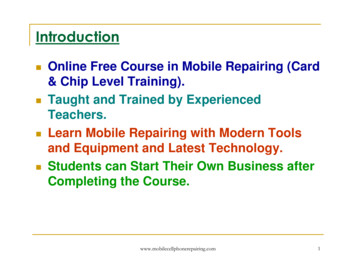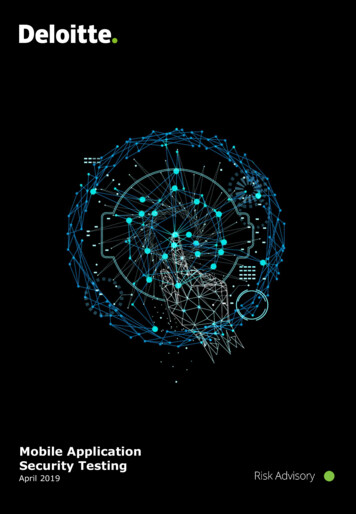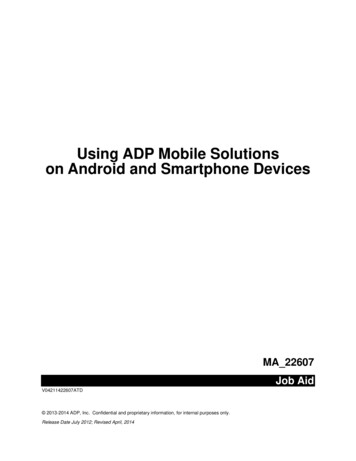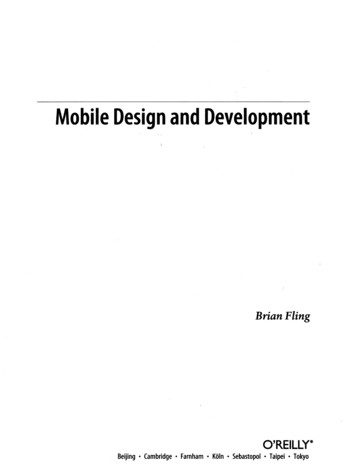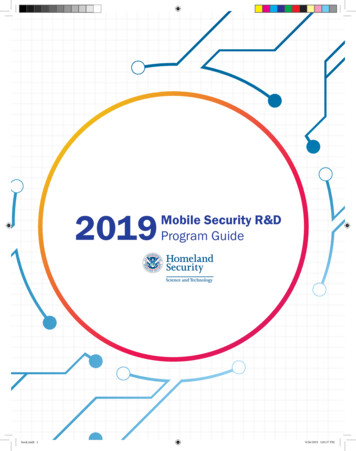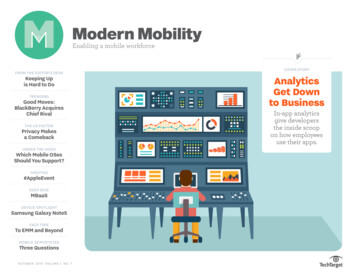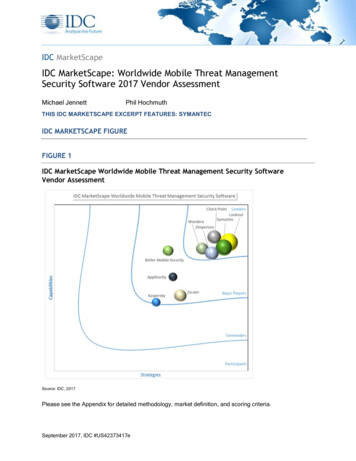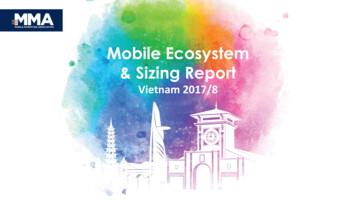
Transcription
A Mobile Application DevelopmentStrategy-Finding ModelGhislain Edgard MBAYEN MBAYENMASTER THESIS 2013INFORMATICS
A Mobile Application DevelopmentStrategy-Finding ModelGhislain Edgard MBAYEN MBAYENDetta examensarbete är utfört vid Tekniska Högskolan i Jönköping inomämnesområdet informatik. Arbetet är ett led i masterutbildningen medinriktning informationsteknik och management. Författarna svarar själva förframförda åsikter, slutsatser och resultat.Handledare:Examinator:Omfattning: 30 hp (D-nivå)Datum:Arkiveringsnummer:Postadress:* Telefon:*Gjuterigatan*5**036 10* 10* 00* (vx)
AbstractAbstractNowadays there are several different types of ways to build a mobile application,through web technologies, or through mobile manufacturers’ languages. Thus, in thisstudy we focus on the three major mobile application development strategies: Native,Hybrid, and Web to Native. This plurality of solutions renders the selection of amobile application development strategy complex. Hence, this study aims atunderstanding how developers deal with the selection of a mobile developmentapproach. This thesis analyses their behaviour thanks to a survey that collects crucialinformation about developers searching habits. The latter analysis concludes thatgeneral guidelines are not sufficient to provide a tailored and accurate selection ofmobile application development approach. Therefore, this study aims at improving theactivity of finding a mobile application development strategy. In addition to this, thepast and current states of the subject are discussed in a critical manner, whichtherefore results in using an analytical research approach. Knowing theaforementioned, a design science research approach is used to outline the iterationprocesses that occurred during this study. Each step of the study is thoroughly treatedthanks to a tailored design cycle.Consequently, a mobile development strategy-finding model has been built bycombining literature review and survey’s results. This model highlights theimportance of the criteria extracted from the literature review and the survey. Tosupport and allow constant self-evolution of the model, a suggestion of web platformis proposed.Finally, this model has been compared with a Titanium model. The result of thiscomparison outlines that the model created in this study seems more usable because itcomprises the three major mobile application development strategies whereas theTitanium model only focuses in native solutions and its own hybrid solution.Moreover, the Titanium model focuses on selling its product rather than showing whyit is better than the other mobile application development strategies.*i
AcknowledgementsAcknowledgementsI would like to thank my supervisor Anders Carstensen for being patient towards mywork during this long process of thesis writing and also for giving me thoroughcomments on how to improve my report. I would like to acknowledge the effort of theCourse Manager of the Master Vladimir Tarasov through the different phases of mythesis investigation. In addition, I would like to express my gratitude to all thecompanies and mobile professionals who accepted to respond to the onlinequestionnaire. Last but not least, I would like to outline my appreciation towards theimmeasurable support of my family throughout the entire thesis.*ii
Key wordsKey wordsMobile;* application;* development;* native;* hybrid;* web;* platform;*Guidelines;*Analysis;**iii
ContentsContents*1* INTRODUCTION*.*9*1.1* BACKGROUND*.*10*1.2* MOTIVATION*.*10*1.3* PURPOSE*&*RESEARCH*QUESTIONS*.*11*1.4* DELIMITATIONS*.*11*1.5* THESIS*OUTLINE*.*12*1.6* KEY*DEFINITIONS*.*12*2* THEORETICAL*BACKGROUND*.*15*2.1* NATIVE*SOLUTIONS*.*15*2.1.1* iOS'.'15*2.1.2* Android'.'17*2.1.3* Windows'Phone'.'19*2.1.4* Others'.'21*2.2* HYBRID*SOLUTIONS* *CROSS PLATFORM*NATIVE*SOLUTIONS*.*22*2.2.1* Titanium'.'22*2.2.2* Phonegap'.'23*2.2.3* Xamarin'.'24*2.2.4* Others'.'24*2.3* WEB*TO*NATIVE*SOLUTIONS*.*25*2.3.1* Seattleclouds'.'25*2.3.2* RareWire'.'25*2.3.3* iBuildApp'.'26*2.4* COMPARISON*BETWEEN*ALL*SOLUTIONS*STATED*.*26*3* METHODOLOGY*.*27*3.1* RESEARCH*FRAMEWORK*.*27*3.2* RESEARCH*DESIGN*.*29*3.3* RESEARCH*APPROACH*.*30*3.4* DATA*COLLECTION*.*31*3.4.1* Primary'data'.'31*3.4.2* Secondary'data'.'32*3.5* RESEARCH*ANALYSIS*.*32*3.6* RESEARCH*CREDIBILITY*.*33*3.6.1* Reliability'.'33*3.6.2* Validity'.'33*3.6.3* Generalization'.'33*4* PREVIOUS*RESEARCH*ON*THIS*SUBJECT*.*35*4.1* PAPERS*IN*FAVOUR*OF*NATIVE*SOLUTIONS*.*35*4.1.1* ies'.'35*4.1.2* *4.2* 1* 2.2* d'mobile'hybrid'application'.'36*4.3* PAPERS*PROVIDING*GUIDELINES*.*36*4.3.1* Mobile'application'development'.'36*4.3.2* .'37*iv
Contents4.3.3* Native'web'hybrid'.'38*4.3.4* 4.3.5* 'are'they'good'enough'.'39*4.3.6* '39*4.4* PAPERS*DISPENSING*FRAMEWORKS*.*40*4.4.1* CrossOplatform'mobile'development'.'40*4.4.2* k'.'41*4.4.3* ions'.'41*4.5* .5.1* Selected'criteria'.'44*4.5.2* Overview'guideline'table'.'47*5* SURVEY*.*48*5.1* *5.1.1* Boundaries'.'48*5.1.2* Establishment'of'the'questions'.'48*5.2* METHODS*USED*TO*REACH*RESPONDERS*.*49*5.3* RESULTS*OF*THE*SURVEY*.*50*5.3.1* What'is'the'name'of'your'app?'.'50*5.3.2* ing'a'mobile'development'architecture?'.'51*5.3.3* .4* 5* * ANALYSIS*OF*THE*SURVEY’*RESULTS*.*55*5.4.1* Processes'.'55*5.4.2* Criteria'.'55*5.4.3* Time'of'research'.'56*6* DEL*.*57*6.1* TITANIUM* *MOBILE*DEVELOPMENT*STRATEGY*MODEL*.*57*6.2* USE*OF*CRITERIA*.*59*6.3* MADSF*MODEL*.*59*6.3.1* Model'.'60*6.3.2* Decisional'schema'.'62*6.3.3* From'decisional'schema'to'the'Algorithm'.'63*6.4* METHOD*TO*SUPPORT*THE*MODEL*.*65*6.4.1* Objective'of'the'web'platform'.'65*6.4.2* Concept'.'65*6.5* .*67*6.5.1* Strengths'of'Titanium'Model'.'67*6.5.2* Weaknesses'of'Titanium'Model'.'68*6.5.3* Strengths'of'MADSF'Model'.'68*6.5.4* Weakness'of'MADSF'Model'.'68*6.5.5* Which'Model'to'choose?'.'69*7* DISCUSSION*.*70*7.1* RELIABILITY*OF*THE*SURVEY’S*RESULTS*.*70*7.1.1* occasions?'.'70*7.1.2* rvers?'.'70*7.1.3* he'raw'data?'.'70*v
Contents8* CONCLUSION*.*71*8.1* RECAPITULATION*OF*RESEARCH*QUESTIONS*.*71*8.2* FURTHER*INVESTIGATION*.*72*9* REFERENCES*.*73*10* APPENDIX*.*78*10.1* SURVEY*RESULTS*(1/3)*.*78*10.2* SURVEY*RESULTS*(2/3)*.*79*10.3* SURVEY*RESULTS*(3/3)*.*80*vi
List of FiguresList of FiguresFIGURE 1 – Android Platform ArchitectureFIGURE 2 – Set of APIs included in Windows Phone APIFIGURE 3 – Smartphone Operating Systems, Shipments, and Market Share, 1Q 2013(Units in Millions)FIGURE 4 – API available for different types of devicesFIGURE 5 – Comparison chart between all solutionsFIGURE 6 – The framework utilized for this studyFIGURE 7 – The general methodology of design science researchFIGURE 8 – Chart illustrating the comparison between web, hybrid and nativeFIGURE 9 – Mobile application framework selection criteria (1/2)FIGURE 10 – Mobile application framework selection criteria (2/2)FIGURE 11 – Overview guideline tableFIGURE 12 – Illustration of the survey’s first questionFIGURE 13 – Illustration of the survey’s second questionFIGURE 14 – Illustration of the survey’s third questionFIGURE 15 – Illustration of the survey’s fourth questionFIGURE 16 – Illustration of the survey’s fifth questionFIGURE 17 – Titanium Web Maturity ModelFIGURE 18 – Mobile Application Development Strategy-Finding ModelFIGURE 19 – Decisional schema for choosing a mobile development strategyFIGURE 20 – MADSF Model AlgorithmFIGURE 21 – First step of the concept of stepstoapp.comFIGURE 22 – Second step of the concept of stepstoapp.comvii
List of AbbreviationsList of sSoftware Development KitHypertext Markup LanguageCascading Style SheetsIntegrated Development EnvironmentOperating SystemInformation TechnologyWindows PhoneUser InterfaceBlackBerryModel View ControllerCross-platform native solutionsInformation and Communication TechnologyMobile Application Development StrategyMobile Application Development Strategy-Finding*viii
Introduction1 IntroductionThis chapter aims at providing the scope of the report through several sectionsincluding the establishment of the background of mobile application development, themotivation for this research, as well as the purpose and research objectives. It alsofocuses on the limitations of the report, the thesis outline and keyword of mobileapplication development.Nowadays mobile phone are assimilated to personal computer except that they aresmaller. This type of phone is commonly called smartphones. Smart is used toillustrate the intelligence of such tiny devices and to remind the calculation powerembedded into it. Several constructors of phone jumped into this market after therevolution of the iPhone in 2007. With their venue many of them created their ownplatform of applications release, which sometimes allow developers to buildapplications with a specific programming language.After a couple of years of evolution, new techniques of mobile applicationdevelopment were unleashed from the clouds. Indeed, hybrid solutions such asphonegap or Titanium help you to encapsulate your application into a nativeapplication by using respectively web technologies such as HTML, JavaScript, CSSor a custom JavaScript SDK. Recently another type of solution has been launchedthanks to great efforts from RareWire and others, which utilizes script technologypython, or ruby and an API in between to ease the creation of mobile application via aweb based interface.Previous research on the subject resulted in establishing guidelines, and minimalframeworks for mobile professionals. Our survey revealed that these guidelines areseldom used. Knowing the aforementioned, this study focuses on establishing a newmodel allowing developers and IT professionals to rely on to find the most suitablemobile application development strategy for their mobile applications projects. Thismodel is called MADSF, which stands for Mobile Application Development StrategyFinding.This model is based on the design science research approach due to its problemsolving nature. This approach is subject to improve activities by following a designcycle. The design science research approach is composed of five process steps:awareness of problem, suggestion, development, evaluation, and conclusion. Thesesteps are geared together with circumscriptions knowledge flows. The analysis of theliterature review facilitates the precision of the problem aforementioned, which fulfilsthe awareness problem process step. The suggestion phase of the design scienceresearch is based on the assumption stated at the end of chapter 4. The developmentstep is represented by the online survey. The evaluation is identified by the analysis ofthe survey’s results and the explanation of the new model established called MADSFmodel. Finally, the conclusion is drawn to confirm that the research questionsmentioned in section 1.3 are answered.From now on the words application and applications will be, respectively, abbreviatedto app and apps.9
IntroductionIn order to settle the base of this study we shall trace the history of mobiledevelopment from 2007, year of the first smartphone with apps, until now.1.1 BackgroundThe year 2007 was a glorious period in terms of innovation. Indeed, the iPhone firstgeneration was launched. It was the revolution of the telecommunication andmultimedia sector. Thanks to its new sharp design, and simplicity of utilisation, theiPhone reached historical sales record with 1,389,000 devices sold in four quarters [1].Apple was not the only one with a revolutionary handset operating system. In fact,Google revealed the first Android phone in October 2008. By that time Apple alreadyhad a major advantage due to the earlier launch of their smartphone a year and halfbefore. Other competitors followed the smartphone wave after a couple of years forinstance windows unveiled its windows phone in October 2010 [2].The real game changer for all those manufacturers was the opening of theirapplication stores named App Store for Apple iPhone, Google Play for Android,Windows Phone Store for Windows Phone. These application stores allow developersto create apps and provide them on the application store. For a yearly subscription feedevelopers can access to the platform SDK and publish as much apps as they wantafter the constructor review of the apps [1][2][3].However, developers rapidly reached programming language development obstacles.Since constructors used different programming languages developers had to decide onwhich platform they would focus themselves and improve their skills. Code reusebecame a major concern for developers. Therefore, groups of developers working onprojects to tackle these drawbacks emerged such as the phonegap project, whichstarted in 2009 [4].After a couple of years many other solutions were created starting from Hybridmobile development solutions and lately web app that enables users to build mobileapplications by dragging and dropping widgets. Nowadays, developers have a widerange of solutions at the tip of their fingers even though sometimes it can beproblematic to choose within the plurality of solutions [5].1.2 MotivationFollowing a work experience in mobile application development, I realized that thework of preparing a mobile application development was time consuming unlessbeing an expert in a dedicated mobile development solution. My work conducted meto choose between several solutions, which took me several days because I had tosearch beforehand the feasibility of some features depending on each platform. Hence,these difficulties resulted in an idea of creating of model that would render theselection of a mobile development solution easier. Some papers elaborated a set ofsolutions described in Chapter 4. Nonetheless, none of them appeared to aim atproviding a model that combines the three major mobile application developmentstrategies. This being said, there is a Titanium model described in Chapter 6 that10
Introductionproposes an approach but it is solely focused on native and its own hybrid mobileapplication development strategy. Consequently, there is a theoretical gap that needsto be fulfilled by the establishment of a model that encompasses the major threemobile application development strategies.1.3 Purpose & Research questionsThe evolution in terms of mobile development solutions has brought several optionsfor developers. Nonetheless, the downside is that new developers have to choosebetween wide ranges of solutions. Hence, this study will aim to investigate andprovide solution to the following statements:!!!What* processes* developers* perform* for* choosing* a* mobile* development*architecture?*What* are* the* criteria* for* which* developers* adopt* a* mobile* application*development*strategy?*How* to* provide* developers* and* companies* with* a* model* that* help* them* to*choose*their*mobile*development*strategy?*In order to support this study a survey was carried out to collect accurate informationabout the mobile development trends from a professional point of view.Based on the analysis of this survey’s results a new model of Mobile ApplicationDevelopment Strategy Finding (MADSF) has been proposed and thoroughlyexplained.1.4 DelimitationsThis study shall face internal and external delimitations. In fact, this study will befocused onto three platforms iOS, Android and Windows Phone, which represent95,5% of the smartphone operating system market share [6] of the first quarter of2013. Hence, the web site will not cover the other OS because their growth isincomparable to the three giants aforementioned and the forecast are not promisingfor them.The second delimitation will concern external difficulties through enterprises barriers.The challenge of the study will be to collect precious data about the current trend interms of mobile application development solutions used for different types ofapplication. Indeed, mobile application development agencies might not be willing toshare this kind of information might be proprietary whether for them or their clients.They might be busy with their daily workload, which will surely postpone theiranswer.11
Introduction1.5 Thesis outlineThe following section of this research report are structured as below:The second chapter contours the history and theoretical background of the three giantmanufacturers named earlier.The third chapter provides information about the methodology used for this study. Italso explains the research method, the theoretical framework and design employed forin this project. Moreover, it denotes the methods and tools utilized for data collection.Thereby, it supports the purpose of this research.The fourth chapter depicts the literature review of the research carried out in order tobring a sight into the theoretical background of mobile application development.The fifth chapter gathers the results of the online survey. Therefore, elaborates onpossible combination of factors and analyses the outcome.The sixth chapter explains the new concept of the MADSF (Mobile ApplicationDevelopment Strategy-Finding) model in comparison with a current model built byTitanium.The seventh chapter discusses about the entire thesis study and especially about thereliability and validity of the survey’s results.Finally, this study is concluded by a summary of the research, deduces the essentialresults of the research and outlines what could be done in further investigations.1.6 Key definitionsIn order to grasp the subsequent chapters of this study, this section provides a set ofdefinitions of frequent technical terms appearing in this report. Consequently, thesekey definitions bring an overall understanding and necessary knowledge of the MobileApplication domain to avoid repetition. Therefore, the table 1 below encloses theaforementioned key definitions.TerminologyMobile ApplicationSDKFrameworkDefinition“A mobile application (or mobile app) is a program,embedded into a mobile device, that performs a specificpurpose. They are distributed through software platformscalled Application Store, such as the Apple App Store,Google Play, Windows Phone Store, and BlackBerry AppWorld.” [7]“A software developer's kit (SDK) is a set of programs usedby a computer programmer to write application programs.Typically, an SDK includes a visual screen builder, an editor,a compiler, a linker, and sometimes other facilities.”
through web technologies, or through mobile manufacturers’ languages. Thus, in this study we focus on the three major mobile application development strategies: Native, Hybrid, and Web to Native. This plurality of solutions renders the selection of a mobile application develop

